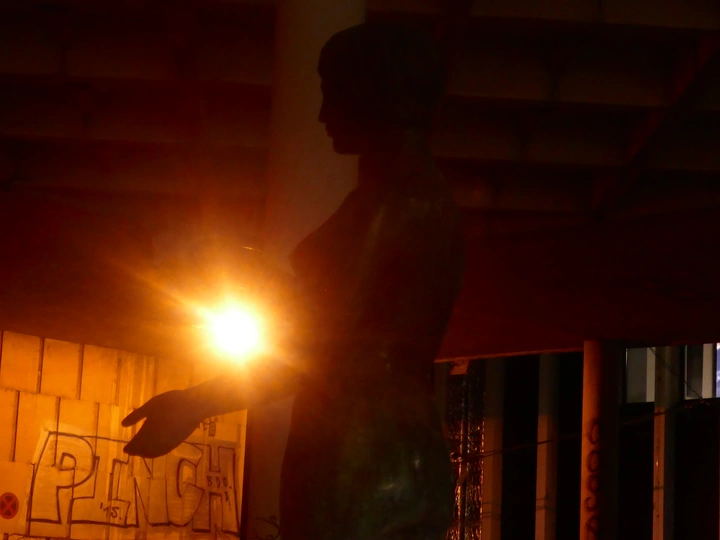Belgrade Liminal: Walking Among Dying Giants (WT)

I am Sanja Vasić (b. 1993), a transdisciplinary artist and independent researcher working across writing, spatial installation, visual arts, and performative storytelling. My work orbits around poetic, intuitive, and embodied ways of engaging with space, often informed by personal history, urban exploration, feminist theory, and psychoanalytic thought. While I am most widely recognized for my poetic voice, I navigate multiple artistic grammars—assembling fragments, atmospheres, and narrative traces into affective, site-responsive forms. Rooted in both theory and sensory experience, my practice often draws inspiration from urban landscapes, architectural remnants, and in-between spaces. I am especially attuned to their emotional charge and temporal layering—how buildings remember, how ruins whisper, how thresholds open imaginative portals. Vivid memory and active imagination shape much of my artistic language, often pulling from autobiographical fragments, transgenerational experiences, and embodied states to evoke spatial and emotional resonance.
I hold two MAs: one in Critical Curatorial Cybermedia (HEAD – Geneva), and another in Textile Arts (Faculty of Applied Arts, Belgrade), where I received the Iva Vrinjanin Foundation Award for my spatial installation. My work has been exhibited and performed across diverse contexts, including Serbia, Switzerland, and Kosovo—at venues such as Théâtre de l’Usine (Geneva), Art Weekend Belgrade (Staklopan and Hotel Belgrade), and Mitrovica Art Residency. In 2024, I received a Jury Award for a video essay from KC Rex & Heartefact. I’ve also worked as a freelance writer covering contemporary art and culture, including a published article on architect Liam Young and his critical, speculative spatial practice. In both independent and collaborative settings, I approach artistic practice as a means of inquiry, transmission, and world-building.
This project engages with liminality as both a theoretical lens and an experiential condition. The term, from Latin limen (threshold), was developed by Arnold van Gennep and expanded by Victor Turner as a zone of anti‑structure and instability. Contemporary theorists like Árpád Szakolczai frame modern society as “permanent liminality.” Similarly, Mark Fisher’s concepts of the “weird” and the “eerie” offer frameworks for reading urban remnants and sites of urban decay—spaces marked by monstrousness and futures that never arrived, serving as sense-making tools in late capitalism. Liminal spaces—corridors, passages, doorways, and infrastructural voids—are not always abandoned. Many exist in decay, partial use, or informal occupation, distorting temporal and spatial flows. They carry atmospheres of estrangement, longing, melancholy, or quiet resistance—embodying tension between presence and absence, what was, what persists, and what might emerge. This project envisions a guided walk offering an alternative reading of Belgrade’s city centre, activating selected sites through live performative readings of curated poetic fragments. These texts derive from a body of work initiated during the artist’s MA (CCC, Geneva) and evolving through lived engagement with the city. The poems speak to memory, urban decay, post-transitional dislocation, feminine embodiment, and trauma. At its core is the mythic figure of the dying giant: a vast, broken megastructure appearing across fragments as both menacing and fascinating, embodying disrupted futurity, in-betweenness, and generational unease in a post-socialist urban context. The walk’s route is defined. The task onward is to align poetic excerpts with site-specific atmospheres—considering rhythm, voice, spatial interaction, and pacing. Supported by LINA, this poetic-spatial methodology could evolve into a modular framework adaptable as sound walks, publications, or video essays, as well as collaborative urban research across contexts.